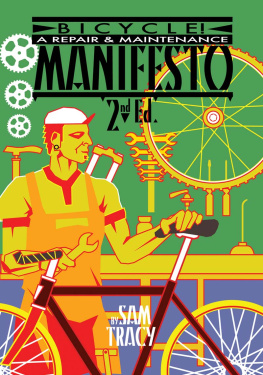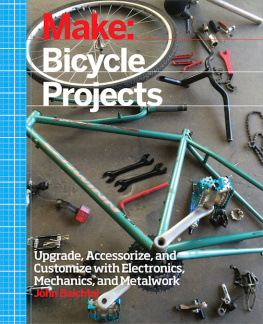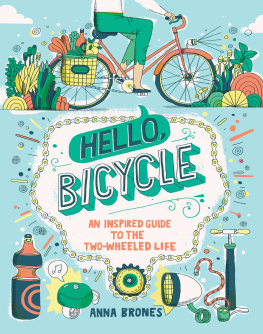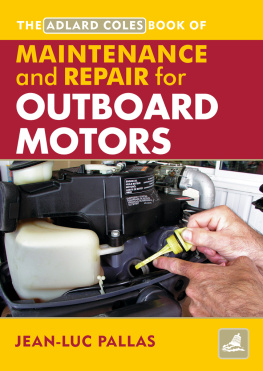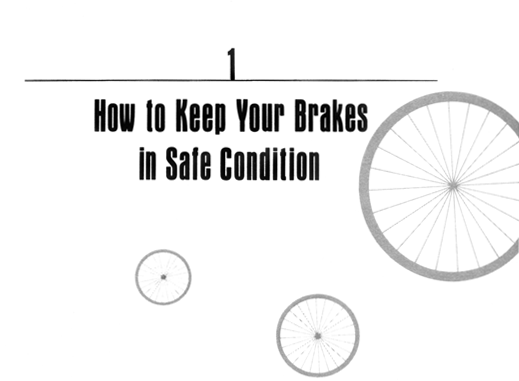
ALSO BY EUGENE A. SLOANE

Sloanes Handy Pocket Guide to Bicycle Repair
Sloanes Complete Book of All-Terrain Bicycles
The Complete Book of Bicycling: All-New 4th Edition
Sloanes New Bicycle
Maintenance Manual
Eugene A. Sloane
A FIRESIDE
Published by Simon & Schuster
New York London Toronto Sydney Tokyo

Fireside
Rockefeller Center
1230 Avenue of the Americas
New York, New York 10020
www.SimonandSchuster.com
Copyright 1981, 1991 by Eugene A. Sloane
All rights reserved including the right of reproduction in whole or in part in any form.
First Fireside Edition 1981
FIRESIDE and colophon are registered trademarks of Simon & Schuster Inc.
Designed by Chris Welch
Manufactured in the United States of America
Library of Congress Cataloging in Publication Data
Sloane, Eugene A.
[New bicycle maintenance manual]
Sloanes new bicycle maintenance manual / Eugene A. Sloane.1st fireside ed.
p. cm.
A fireside book.
Includes index.
1. BicyclesMaintenance and repairHandbooks, manuals, etc. I. Title.
TL430.S59 1991 91-14699
629.28772dc20 CIP
ISBN 0-671-61947-0
eISBN: 978-1-451-60268-5
Grateful acknowledgment is made for permission to reprint from the following articles:
Frame Repairing and Refinishing, by Otis Childress, from Bike World (October 1977, Volume 6, Number 10).
Tips to Inexpensive Frame Painting, by Otis Childress, from Bike World (January/February 1979, Volume 8, Number 1).
 Contents
Contents Introduction
IntroductionIf you can handle a screwdriver, a wrench, and a few other simple tools, you can learn to keep your bicycle in tip-top working condition. I will explain how to adjust the brakes for safe, reliable, stopping power. You will see how to keep the over 100 ball bearings in the working parts of your bicycle clean and the bearing surfaces correctly adjusted for smoother, easier pedaling and longer component life. And you will find that the chain can, when properly maintained or replaced, withstand the stress of uphill climbs without breaking.
Best of all will be the knowledge that once you have overhauled your bicycle, nothing can go wrong (short of a broken frame) that will hold you up for very long on a camping trip, a spin through the park, or a commute to work.
In this book we will concentrate primarily on all aspects of keeping your bicycle safe and in good repair. For details on the prevention of injury, for evaluation of bicycles and their parts, tips on safe riding, commuting and bike tripping, racing and bike history and lore, please refer to my expanded volume, The Complete Book of Bicycling.
I am grateful to the folks at Shimano, SunTour, Campagnolo, and a host of other component manufacturers for their help in providing technical details, drawings, and photos on their latest products. Performance Bicycle Shop, the bike catalog and retail outlet people, were most helpful, as were Park Tools and the tool catalog organization, The Third Hand.
.. Be sure you can stop your bicycle in time to avoid an accident. Use the braking methods below, and follow the brake adjustment instructions shown here to get maximum stopping power from your brakes.
BRAKING TECHNIQUE
Before we get into brake maintenance, heres a brief review of safe brake operation. First, remember that your front brake provides 90 percent of the total braking power of both brakes combined. Let me illustrate. Place a book on the table, with one end against your hand. Think of that hand as the front brake. Now, with the other hand, push the book. You will see that the brake hand stops the book, but the rear of the book rises up off the table. That is what happens when you apply the brakes. The rear wheel tends to rise in the air and lose contact with the ground. Obviously, the less contact, the less braking power. If for some reason your rear brake is not working (for all the reasons I cite below in the brake adjustment section), the front wheel may lock up. When that happens you could be pitched forward off the bike and get hurt. Which is a good reason to make darned sure both your brakes are in good working order.
Always apply both brakes at the same time, never the front one alone. If you apply only the front brake you risk an endo or a pitch over the handlebars. Another reason for the poor performance of the rear brake is its much longer cable. Just the part of the cable that goes through the spaghetti tubing measures 9 inches on the front and some 30 inches on the rear brake on a typical all-terrain bicycle. The extra 21 inches of cable tubing means a lot more friction at the brake lever. It takes more hand pressure to apply the rear brake than the front one. The longer rear cable also stretches far more than the shorter front cable.
If youre going downhill fast, keep your weight as far back as possible for maximum braking ability. If you have to make an emergency stop on the flats, shift your bottom as far back on the saddle as possible as you brake. That way you put more weight over the rear wheel for safer braking.
Brake before you corner! If you brake as you corner the bike could skid out from under you. Slow down before you come to a sharp turn. Keep the inboard pedal upright for maximum pedal-to-ground clearance.
The U.S. Consumer Products Safety Commission requires that a rider of 150 pounds going at 15 mph on a flat, smooth, dry surface (such as a concrete roadway) with the wind velocity less than 7 mph (direction not specified) be able to stop within 15 feet of initial brake application (both brakes). As a practical matter, the heavier you are the longer its going to take you to stop. Conversely, the lighter you are the sooner you can stop, so muscular heavyweights should anticipate braking needs for a safe, controlled stop. Practice braking on a variety of surfaces such as sand, gravel, or cement until you become familiar with how the brakes work, and how you and the bike react to them. Be especially careful on slippery surfaces, such as sand, snow, mud, or ice. Avoid braking so hard that you lock up one or both wheels. Check your brakes every 500 miles or every two months of riding time (not calendar time). Heres how. On a dry, hard-surfaced, traffic-free street, chalk a length of 15 feet. If you have a speedometer on your bike, fine. If not, just get going at a good clip, to an estimated 15 mphwhich is a lot faster than you may realize on a bike. Most of us, if we dont know, almost always think were going faster than we are. Once up to speed, apply both brakes, carefully at first. If you overshoot and cant stop within 15 feet, make several tries. Apply the brakes harder each time. If you always overshoot, your brakes are defective.
Next page

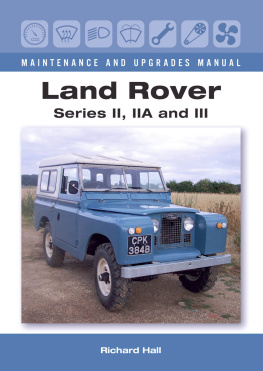
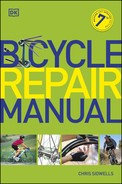
![Shanks - Essential bicycle maintenance & repair: [step-by-step instructions to maintain and repair your road bike]](/uploads/posts/book/235248/thumbs/shanks-essential-bicycle-maintenance-repair.jpg)
